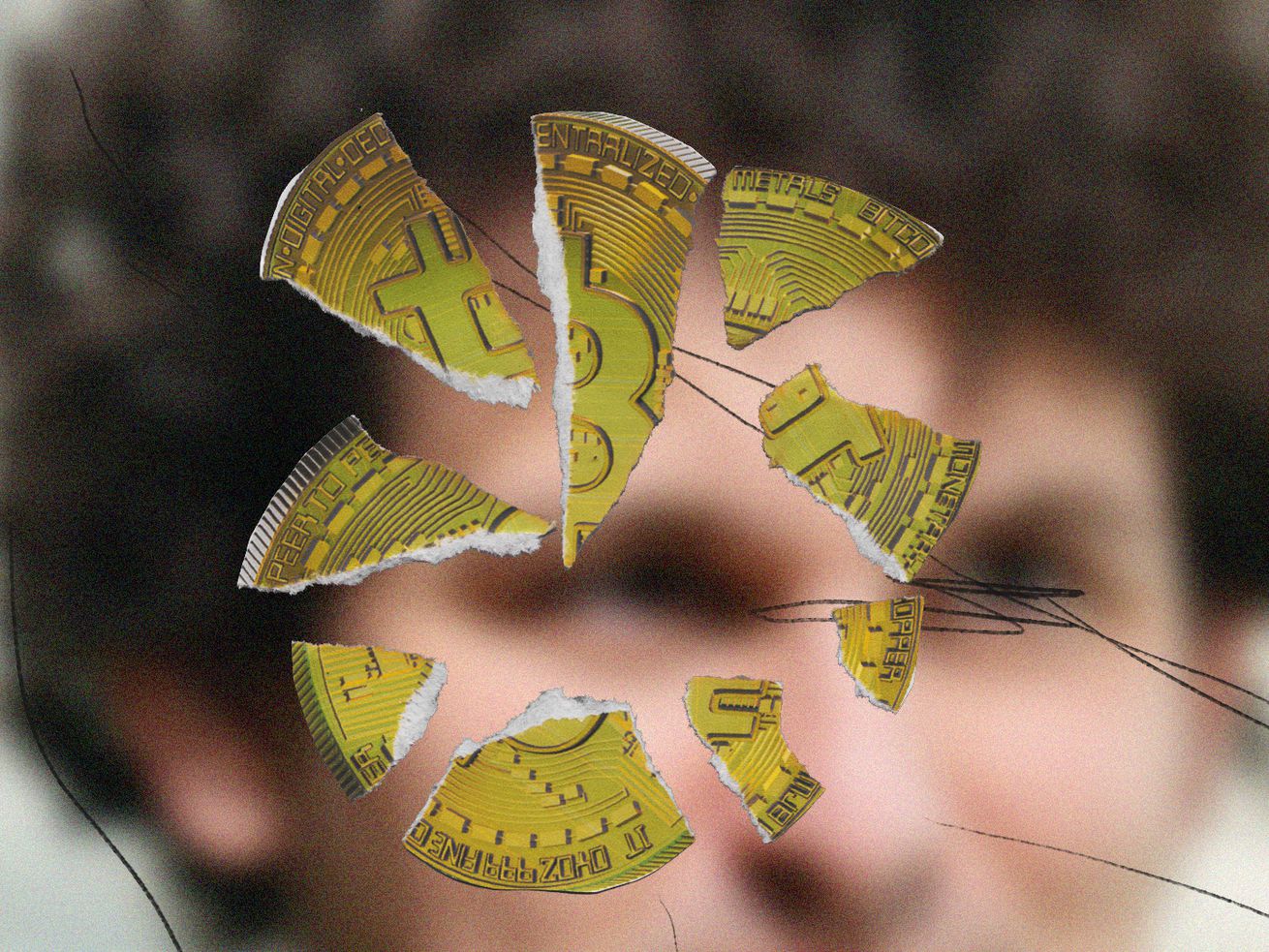FTX and Sam Bankman-Fried just experienced a shocking downfall.
Sam Bankman-Fried, one of the crypto industry’s biggest stars, has said a lot of things over the years, most recently that he’s “sorry” and he “fucked up.”
Before that, he said he might spend as much as $1 billion on politics in 2024. He said he had a lot of ideas for policing the crypto industry and using his crypto-fueled fortune for good. He said he’d be fine bailing out some crypto companies in trouble as crypto winter hit over the summer. All of these claims are now in limbo thanks to another thing he said on November 7: that his crypto exchange, FTX, was “fine.” It was not. Instead, the next day, the exchange imploded. By Friday, November 11, the company had filed for bankruptcy, and Bankman-Fried resigned as CEO.
“It’s incredible how quickly these things can spiral out of control,” Molly White, a software engineer and prominent crypto critic behind the website Web3 is Going Just Great, told me.
Whether or not you’re a crypto person, chances are you’ve come into some sort of contact with FTX and its founder, Sam Bankman-Fried — better known as SBF — in some fashion. He’s partnered with big names, such as soon-to-be-divorced couple Tom Brady and Gisele Bündchen, to spread the crypto gospel. He co-hosted Crypto Bahamas with medium name Anthony Scaramucci; figures such as Bill Clinton and Tony Blair attended. (Disclosure: Future Perfect, Vox’s effective altruism-inspired vertical, received a grant from Bankman-Fried’s Building a Stronger Future foundation in 2022.)
FTX ran a memorable ad featuring Larry David during the Super Bowl encouraging people to jump into crypto, even if they didn’t really get it. He bought the naming rights to the Miami Heat’s arena; whether that name will soon have to change is uncertain. Bankman-Fried was a major donor to Joe Biden’s presidential campaign and again in the 2022 midterms, largely in primaries. He slowed political spending down in the election cycle’s final weeks. He had positioned himself as the “acceptable” face of crypto to Washington, DC, policymakers, and the public.
In a matter of days, his empire has exploded in a rather spectacular fashion. Thanks to a leak about the financial health of a trading firm he founded, Alameda Research, and some savvy maneuvers from a competing exchange, Binance, investors began to pull their money out of FTX en masse. FTT, a token the company issues, plunged in value. FTX was forced to seek a bailout.
The competitor that helped orchestrate FTX’s demise said it would buy it and then backed out after briefly kicking FTX’s tires. Billions of dollars have been wiped from Bankman-Fried’s net worth. It’s still not entirely clear what happened, why it happened so quickly, or what will happen to FTX or its customers. Regulatory probes are certainly on the horizon. It appears that FTX is facing an $8 billion shortfall and has commenced bankruptcy proceedings in the US.
John J. Ray III, who has been tapped as FTX’s new CEO, said in a statement on Friday that Chapter 11 is “appropriate to provide FTX Group the opportunity to assess its situation and develop a process to maximize recoveries for stakeholders.” Bankman-Fried, who in recent days has said he’s intent on finding ways to help customers who can’t get their money out of the exchange, will remain on to assist in the transition. It’s hard to see this ending well. As Bloomberg notes, Chapter 11 bankruptcy means the company can keep operations going as it figures out how to pay creditors. Some 130 entities, including FTX, FTX, and Alameda Research, are involved in the proceedings.
In a series of tweets on Friday, Bankman-Fried reiterated that he was sorry. “I’m piecing together all of the details, but I was shocked to see things unravel the way they did earlier this week,” he wrote.
Crypto has seen a series of blowups over the past decade, and this is among the biggest — the industry’s Bear Stearns moment, in a way.
“Sam went from being the darling of the regulators to suddenly being a pariah, and it happened in a matter of what? Three days?” said Douglas Borthwick, chief business officer at INX, a crypto trading platform. “Astounding.”
FTX’s shocking implosion, explained-ish
In some ways, the story of what happened here is a bit of a classic one — one competitor (Binance) saw the opportunity to try to kill off another (FTX), so it did.
“This is two crypto exchange founders doing economic warfare, and one clearly won and one clearly lost,” said David Hoffman, the co-owner of Bankless, a podcast and newsletter in the crypto space.
How it was able to do so is a little complicated, and there’s still a lot that’s unknown.
Changpeng Zhao, a Chinese-born entrepreneur with Canadian citizenship who is more commonly referred to as CZ, launched Binance in 2017 and has since grown it to be the biggest crypto exchange in the world. Bankman-Fried launched Alameda Research, a quantitative trading firm focused on digital assets, in 2017, and then FTX, an exchange, in 2019. Bankman-Fried stepped away from running the day-to-day at Alameda, but the two entities remained very much connected.
Up until very recently, the story was that FTX and Alameda were in decent shape. FTX had a $32 billion valuation, its smaller FTX US division (that’s in line with US regulations and doesn’t allow nearly as much risky behavior as regular FTX does) was pegged at $8 billion, and Alameda had brought in a $1 billion profit in a single year. Things have since fallen apart very fast.
On November 2, Ian Allison at CoinDesk published a leak revealing that much of Alameda’s $14.6 billion in assets were parked in a digital token created by FTX, called FTT. (In crypto, tokens are digital assets built on a blockchain.) Among other perks, FTT tokens give holders a discount on FTX trading fees. But the tokens were, like a lot of crypto tokens, kind of a made-up thing where their value was derived in believing there was value. “They printed this token out of thin air, endowed it with some valuation, and then Alameda used it as collateral,” said Nic Carter, partner at venture capital firm Castle Island Ventures.
Bloomberg’s Tracy Alloway used the example of a Beanie Baby you buy for $5 and then sell for $20 because you make a price guide saying that’s what he’s worth. In this case, FTX was making the Beanie Baby itself — as in issuing the FTT token for free — then buying some of the tokens back for whatever amount. It was then able to say the token was worth that amount and do business with it, by, for example, using it as collateral for a loan.
The CoinDesk leak and revelations that it had so much money in FTT prompted questions about Alameda’s financial health and concerns that a fall in the token’s value could cause real problems for both the trading firm and FTX.
Days later, on November 6, Zhao said on Twitter that Binance would be liquidating its FTT holdings, which it received after exiting its stake in FTX last year. (Binance was an investor in FTX, with Zhao buying a 20 percent stake in the exchange soon after its launch, according to Reuters.) He said Binance received $2 billion in tokens, including some in the FTX token, at the time, but due to “recent revelations that have come to light,” they were offloading the FTT.
The whole thing sort of spiraled from there. Alameda’s CEO, Caroline Ellison, insisted Alameda was fine and offered to buy Binance’s FTT at $22 a token, around where it was at the time. Bankman-Fried claimed FTX’s assets were fine. Investors didn’t believe them.
FTT’s value plunged to under $5 as holders made a mad dash to sell, and customers started trying to pull their money out of FTX altogether. The exchange suffered from a liquidity crunch, meaning it ran out of money. By Tuesday, November 8, it became clear that this was all sort of the “this is fine” meme but the fire had engulfed the building and everyone in it. Bankman-Fried announced that FTX had reached a “strategic transaction” to hand FTX over to Binance (but not FTX US). Zhao said Binance had signed a non-binding letter of intent to buy FTX, pending due diligence. The non-binding part wound up being important as reports soon began to emerge that Binance might back out, which it eventually did.
“As a result of corporate due diligence, as well as the latest news reports regarding mishandled customer funds and alleged US agency investigations, we have decided that we will not pursue the potential acquisition of FTX.com,” Binance said in a series of tweets. “In the beginning, our hope was to be able to support FTX’s customers to provide liquidity, but the issues are beyond our control or ability to help.”
On Tuesday in a letter to investors, which include SoftBank, Tiger Global, and the Ontario Teachers’ Pension Plan, Bankman-Fried said he was “sorry” he’d been hard to contact amid all the drama and that the “details are still being hashed out” in the Binance deal — a deal that he noted was non-binding and, ultimately, would soon be defunct. “Our first priority is to protect customers and the industry; that’s been guiding what we do,” he wrote. Bankman-Fried did not respond to a request for comment from Vox.
On the morning of November 9, Zhao tweeted out a note he’d sent to the Binance team saying he “did not master plan this or anything related to it” and that he had “very little knowledge of the internal state of things at FTX” before Bankman-Fried called asking for help. (To be sure, his tweet earlier in the week indicated he had a hunch otherwise.) Semafor reported on November 8 that FTX had tried to get a bailout from Silicon Valley and Wall Street investors before resorting to Binance; many of FTX’s investors reportedly say they were blindsided by the deal.
“Binance saw something at FTX, they realized there was a vulnerability — we don’t know what it was yet — and realized they could take them out, which they did. It was really an incredible strategic move,” Carter said. “For Sam to sell to his literally biggest competitor, it definitely is a tough pill to swallow, so clearly something was very awry.”
This wasn’t the beginning of Zhao’s and Bankman-Fried’s simmering rivalry — the former didn’t love the latter’s policy outreach in the US — but it was the first time it had boiled over in such a big way. The potential deal signaled a detente, but now, it appears the hostilities remain. “At some point I might have more to say about a particular sparring partner, so to speak,” Bankman-Fried tweeted on Thursday in an apparent reference to Zhao. “But you know, glass houses. So for now, all I’ll say is: well played; you won.”
There are still a lot of unknowns here
Exactly why FTX and Alameda were so vulnerable is not entirely clear, and there’s more to be learned in the days, weeks, and months to come.
In a call with investors on Wednesday first reported by the Wall Street Journal, Bankman-Fried told investors he needed $8 billion to cover all of the requests customers were making to withdraw their money. Sequoia Capital has written down its investment in FTX to $0, meaning it thinks it’s worthless.
Since things began to fall apart in early November, there’s been quite a bit of speculation as to what happened. Some theories observers floated to me in conversation were that FTX wasn’t completely solvent, or they weren’t adequately backing customer deposits, or FTX was trading with customer deposits. Reuters reported that Bankman-Fried had transferred at least $4 billion in funds to Alameda to prop the firm up after it had suffered losses, a portion of which were customer deposits. He reportedly didn’t tell other FTX executives about it because he was nervous it would leak.
The long and short of it is that when you give your money to a crypto exchange, you are supposed to be able to get it back when you want to. That means “a client fund needs to be segregated, whether that’s dollars or whether that’s crypto,” Borthwick said. And if the exchange isn’t holding onto the client funds but is instead lending them or trading them (as Matt Levine at Bloomberg points out, banks, for example, lend customer deposits), then it runs the risk of not having the money to hand back to clients, especially when the clients come asking for the money all at once. In a tweet on Thursday, Bankman-Fried insisted that FTX has a “total market value of assets/collateral higher than client deposits,” but that’s not the same as liquidity — he’s saying FTX still has that customer money, they just can’t get it out of the things it’s in.
“In a very real way, SBF did this to himself, and its impacts will be felt across the ecosystem even by those trying to make a real difference,” said Scott Moore, the co-founder of Gitcoin, a project for building and funding Web3 open source infrastructure, referring to other projects in the space around areas like decentralized finance and public works.
Bankman-Fried offered up some explanations on Thursday, though he acknowledged he is still “fleshing out every detail” of what happened and that he believes he “fucked up twice,” including “poor internal labeling of bank-related accounts.”
Many people I spoke with also wondered where the original leak to CoinDesk came from.
Alex Svanevik, CEO of blockchain analytics platform Nansen, said that whatever the case, it’s clear FTX was not as transparent as it should have been about what it was doing with assets and deposits. “At some point, because of the situation with the FTT price [falling] and the information that Alameda had these positions that were collateralized with the FTT token and all of these things, it translated to a bank run on FTX,” Svanevik said, referring to the colloquial term for when a critical mass of customers removes their money from a financial institution over solvency fears. “The great irony is that of course SBF was the guy who was in Washington trying to engage with regulators, and it looks like he didn’t have his own house in order.”
What happened is not entirely different from what transpired when crypto lender Celsius filed for bankruptcy earlier this year or when crypto broker Voyager or another crypto lender, BlockFi, went under.
“People park money with these different entities and then trust these entities with having control over the funds, and on the back end, these entities are doing frankly irresponsible things with customers’ deposits,” Svanevik said. It causes problems because crypto’s very volatile, so valuations can fluctuate quickly and make it riskier than more traditional assets.
Compounding everything is that when some crypto entities fell apart earlier this year, Bankman-Fried offered to step in to try to save some of them. Now, he’s the one that needs help, and it’s not clear what will happen with any of the deals he made to help out others when things were still supposedly good at FTX. “I think it’s actually possible that none of those deals are consummated,” Carter said. FTX’s downfall has triggered concerns about a sort of crypto contagion, where one failure leads to another leads to another. BlockFi, which FTX had inked a bailout agreement with over the summer, said it would pause client withdrawals on Thursday and asked that no one make deposits into their wallets or accounts “given the lack of clarity” on the FTX, FTX US, and Alameda situation.
“The last several months, FTX was coming out as the savior of the industry and trying to help others,” said Reena Aggarwal, a professor of finance at Georgetown. “Could there be another white knight that shows up to help FTX? Who knows.” It appears no new white knight is in sight.
Semafor — in which, ironically, Bankman-Fried was an initial investor — reported on Wednesday that all of FTX’s legal and compliance staff have quit. Alameda Research’s website is now private, and Bankman-Fried said on Thursday that the fund was winding down trading. According to Bloomberg, regulators in the US are looking into whether FTX mishandled customer funds and the relationships among FTX, FTX US, and Alameda.
“FTX could have been squeaky clean for all we know, but when the largest player in the space turns and says, ‘I don’t like this company and I’m dumping everything I own in it,’ then the whole market starts to get worried and says, ‘It doesn’t matter if everything’s great there, I’m getting my money out,’” Borthwick, whose own exchange runs entirely within the lines of US securities laws, said. “If it was a regulated bank, the Fed would have stepped in, but it’s not.”
Whether this was a Bear Stearns situation, a Bernie Madoff scenario, or something else entirely, for customers holding money on the exchange, it doesn’t really make a difference if they don’t get that money back, which it’s unclear they will. Not to mention the investors who backed FTX and will very likely not be seeing a return on that investment and will lose most or all of their capital.
“It doesn’t matter what the scheme was on the back-end if you can’t get your money out,” Svanevik said. “They exercised poor risk management and they jeopardized customers’ deposits, which they shouldn’t do.”
Crypto is still a roller coaster you might want to stay off of
FTX’s implosion has been nothing short of spectacular. While many people I spoke with noted they’d had some hesitation about FTX and Alameda intermingling in the past and potential conflicts of interest, most acknowledged they really did not expect this to happen this fast and in this way.
“[FTX] was so intent on legitimizing themselves and getting in the DC policy orbit,” Carter said.
Bankman-Fried’s power is diminished. He’s really positioned himself as the face of crypto and certainly of FTX (the company literally runs ads featuring him), and there’s some real reputational damage here. His regulatory and political investments, at least for the time being, are quite worthless, as is his weight in the crypto policy arena.
“The bill that Sam was working on is dead in the water, crypto loses some of its luster among these politicians that FTX was cozying up to,” Carter said. “There’s a renewed sense that this industry is just totally unregulated and run by crooks and fraudsters.”
“A key pillar of FTX’s marketing strategy has been to elevate the personal brand of SBF, and that’s where a situation like this becomes, frankly, quite embarrassing,” Svanevik said. “It just makes it look like a charade or something, like he was fooling people.”
Bloomberg estimates that Bankman-Fried’s personal wealth has been wiped out; his net worth had been pegged at nearly $16 billion at the start of the week, and is believed to have peaked at $26 billion in March. He is a major player in philanthropy and, specifically, the effective altruism movement, where adherents — including some like Bankman-Fried who are or aim to become ultra-wealthy — give away money to try to do the most good for the most people. His plunging net worth means significantly fewer funds for the causes he cares about — including pandemic prevention — and the effective altruism community has acknowledged the potential impact. The team behind Future Fund, his philanthropic collective, has resigned. In a letter announcing their resignation, the team said it “looks likely that there are many committed grants” that the fund will not be able to honor, leaving many organizations that thought they were getting money from the fund in the lurch.
Whatever happens with FTX, Bankman-Fried, and this specific situation, the entire episode draws attention to a consistent theme in crypto: It remains very much the Wild West. Even the best-known billionaire (who may be a billionaire no longer) advancing this new technological and financial paradigm can wind up in a house-of-cards, smoke-and-mirrors scenario. Bankman-Fried’s “FTX is fine” declaration is reminiscent of a message another prominent crypto figure, Do Kwon, sent over the summer when his operation collapsed, telling his customers, “steady lads.”
“It’s remarkable, again and again, how crypto personalities like SBF will claim that everything is fine up until the very second they have to admit it isn’t,” White said. Much of crypto hinges on the belief that everything is fine and that coins and tokens have value … unless and until that belief dissipates.
The prices of many cryptocurrencies have declined in the wake of the FTX revelations. Binance, which has previously come under regulatory scrutiny of its own, has highlighted its own “commitment to transparency” in an effort to shore up confidence it won’t wind up like FTX. The share prices of Coinbase and Robinhood have fallen. Even people in the crypto space who don’t particularly love Bankman-Fried — including Zhao — acknowledge FTX’s troubles are bad for the industry. “Do not view it as a ‘win for us,’” Zhao wrote. “User confidence is severely shaken. Regulators will scrutinize exchanges even more.”
The regulatory waters around crypto remain murky, and it’s not clear what consequences there will be for FTX or for the broader crypto industry. Every time there’s a blow-up like this, there are calls for greater scrutiny on the arena overall, but many regulators and policymakers remain behind the curve. It’s worth noting that up to now, a lot of them were listening to Bankman-Fried, too. (I interviewed Bankman-Fried about meme investing and regulations in 2021, when he told me, “Some things are clearly legitimate and some things are clearly bullshit, and there’s also this long tail of things that are a little bit confusing.”)
“SBF was just spending a lot of time in DC schmoozing with lawmakers and giving recommendations on possible crypto regulation, acting as the ‘adult in the room’ and the liaison from the crypto industry,” White said. “If I was those legislators, I would be questioning a lot of his suggestions.”
“Everyone wants to go bankless until they get punched in the face, and after they get punched in the face they say, ‘Hold on, where are the regulators?’” Borthwick said. But, he noted, this saga is very much still unfolding. “This isn’t the end of it.”
Update, November 11, 10:45 am: This story was originally published on November 10 and has been updated to reflect FTX’s bankruptcy filing, Bankman-Fried’s resignation as CEO, and developments at his Future Fund.
Author: Emily Stewart
Read More



